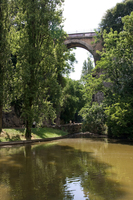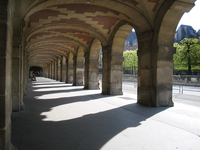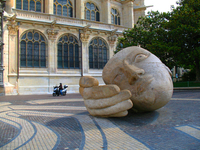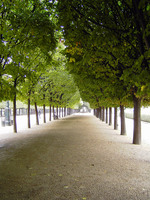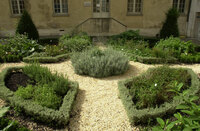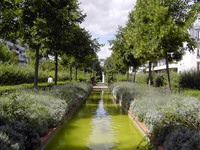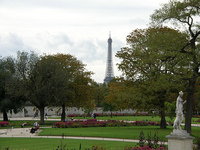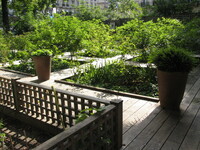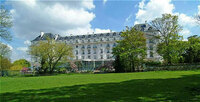- England
- Scotland
- France
- Holland
- Germany
- Italy
- Spain
- Portugal
- USA
- China
- Japan
- India
- Iran
- Advice
- Gardens
- England
- Scotland
- France
- Holland
- Germany
- Italy
- Spain
- Portugal
- USA
- China
- Japan
- India
- Iran
- Advice
- Garden Tours
Parc de la Villette, in Paris, was the first major landscape design to draw upon deconstructionist philosophy. It was the result of a competition won by Bernard Tschumi. Tired of the old idea of a 'park', Tschumi wished to design 'the largest discontinuous building in the world'. Jacques Derrida, the philosopher, encouraged him to consider form before function. This anti-modernist approach 'deconstructed' the traditional procedure. Tschumi laid down three geometries: of points, lines and curves. Clashes were encouraged. The points took the form of a collection of steel pavillions, inspired by Russian Constructivist art and painted red. The primary lines are not unlike traditional French avenues. The most dramatic curved feature is the Cinematic Promenade. Alongside the Promenade are a number of themed areas. Alexandre Chemetoff's Bamboo Garden is an exotic oasis. There is a Fog Garden (by Alain Pélisier), a Dragon Garden, a Mirror Garden (by Tschumi), a Wind and Dune Garden.
DETAILS OF THE THEME GARDENS
Le jardin des Voltiges The garden Fly (designed by Bernard Tschumi), takes its name from its equipment, games movements and balance, is also the theater . Ttwo domes allow two people at a distance of several meters to converse in whispers.
le jardin du Dragon . The garden of the Dragon (François Ghys and B. Tschumi) is an 80 m long slide. Although the dragon is for children, it is not uncommon to see adults using it .
le jardin des Bambous. A staircase is lined with tiny cascades leading down to the Bamboo Garden (designed by Alexandre Chemetoff ), 6 m lower than the rest of the park. The leaves of the trees range from gold to dark green. Their trunks are sometimes clear and sometimes black. To respond, Daniel Buren has drawn on the floor of black and white bands of pebbles. Water is everywhere, falls in ribbons along a huge vertical concrete cylinder designed by Bernhard Leitner. There is strange electro-acoustic music.
le jardin des Miroirs . The walk starts in the west of the Great Hall from the garden Mirrors of (designed by B. Tschumi). Its 28 concrete monoliths erected among Scots pine and maple trees. The walker who ventures to the end of the garden discovers a dreamlike landscape reflected by 28 mirrors.
Le jardin des Ombres Garden of Shadows (designed by Ursula Kurz) is a grid with alternating slabs mainly black, white or seemingly random. The garden promotes the appreciation of humor, friendliness or intimacy, reinforced by scholars games.
Le jardin des Équilibres The changing colors of the garden of equilibria (designed by B. Tschumi), has large metal kites - like giant birds, among the vegetation.
Le jardin de la Treille (designed by Gilles Vexlard, Latitudes North) has 90 small fountains murmuring among grape vines. Jean-Max Albert bronze sculptures are on the railing that overlooks the whole.
(B. Tschumi) ravive de lointains souvenirs chez le promeneur quand il lui faut traverser une mystérieuse forêt d'épicéas bleus et de bouleaux baignée d'une étrange musique
Le jardin des Frayeurs enfantines. The garden of childhood fears (B. Tschumi) revives memories through a mysterious forest of blue spruce and birch bathed in a strange music
Il faut enjamber le canal de l'Ourcq pour gagner le jardin des Îles (B. Tschumi), où des allées pavées de marbre noir et blanc serpentent entre de petits monticules boisés. Au cœur du jardin, une fine nappe d'eau voile une grande dalle de granit, reflétant la lumière dansante du ciel parmi les frondaisons. Chênes, pins gris argentés, tulipiers de Virginie, charmes, conifers
le jardin des Îles The garden of Islands (B. Tschumi) has driveways paved with black and white marble winding between small wooded mounds. At the heart of the garden, a thin layer of water flows over a large granite slab, reflecting light in the sky among the foliage. There are oaks and pines..
L’Artère. The artery (designed by Fabrice Hyber) is located in the heart of the Park and is a commemorative work on HIV. It is a path open to life and fate, a tribute to all those who fought and still fight against AIDS. The work is composed of 16 000 ceramic tiles.
avenue Jean-Jaures, Ile-de-France, Paris, France, 75019
All year, Daily, Open 24 hours/day
Entrance free
